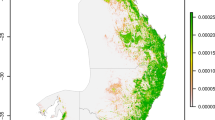Abstract
Sampling designs considered for a national scale environmental monitoring programme are compared. Specifically, design strategies designed to monitor one aspect of this environmental programme, agro-ecosystem health, are assessed. Two types of panel survey designs are evaluated within the framework of two-stage sampling. Comparisons of these designs are discussed with regard to precision, cost, and other issues that need to be considered in planning long-term surveys. To compare precision, the underlying variance of a simple estimator of mean difference is derived for each of the two designs. A variance and cost model accounting for the different rotational sampling schemes across designs are developed. Optimum stage allocation for each design are assessed with the variance-cost models. The best choice of design varied with the conditions underlying the variance model and the degree of other sources of survey error expected in the programme.
Similar content being viewed by others
References
Berger, M.P.F. (1986) A Comparison of Efficiencies of Longitudinal, Mixed Longitudinal, and Cross Sectional Designs. Journal of Educational Statistics, 11, 171–81.
Cochran, W.G. (1977) Sampling Techniques. New York: Wiley.
Cook, N. and Ware, J. (1983) Design and Analysis Methods for Longitudinal Research. Annual Review of Public Health, 4, 1–23.
Cotter, J. and Nealon, J. (1987) Area Frame Design for Agricultural Surveys. National Agricultural Statistics Service, Washington, DC.
Dahl, T.E. and Johnson, C.E. (1991) Status and Trends of Wetlands in the Conterminous United States, Mid-1970's to Mid-1980's. US Department of the Interior, Fish and Wildlife Service, Washington, DC, 28 pages.
El-Shaarawi, A.H. (1993) The Role of Environmetrics. Bulletin of the International Statistical Institute, 8, 287–94.
Ember, L.R. (1995) Environmental Monitoring and Assessment Program Scaled Back. Civil and Engineering News, 18–23.
Fecso, R., Tortora R., and Vogel, F. (1986) Sampling frames for agriculture in the United States. Journal of Official Statistics, 2, 279–92.
Goebel, J.J. and Baker, H.D. (1982) The 1982 National Resources Inventory Sample Design and Estimation Procedures. US Department of Agriculture-Soil Conservation Service, Washington, DC, 43 pages.
Groves, R.M. (1989) Survey Errors and Survey Costs. New York: Wiley.
Gurney, M. and Daly, J.F. (1965) A Multivariate Approach to Estimation in Periodic Sample Surveys. Proceedings of the Social Statistics Section, American Statistical Association, 242–57.
Hansen, M.H., Hurwitz, W.N. and Madow, W.G. (1953) Sample Survey Methods and Theory-Volume II. New York: Wiley.
Huang, E.T. and Ernst, L.R. (1981) Comparison of an alternative estimator to the current composite estimator in CPS. Proceedings of the Section on Survey Research Methods, American Statistical Association, 303–08.
Jabine, T., King, K. and Petroni, R.J. (1990) Survey of Income and Program Participation Quality Profile, United States Department of Commerce, Washington, DC.
Kasprzyk, D., Duncan, G., Kalton, G. and Singh, M.P. (1989) Panel Surveys. New York: Wiley.
Kish, L. (1965) Survey Sampling. New York: Wiley.
Kish, L. (1988) Multipurpose sample designs. Survey Methodology, 14, 19–32.
Lesser, V.M. (1992) A comparison of periodic survey designs employing multi-stage sampling. Institute of Statistics, Mimeo Series No. 1897T, University of North Carolina, Chapel Hill, NC.
Lessler, J.T. and Kalsbeek, W.D. (1992) Nonsampling Error in Surveys. New York: Wiley.
Machin, D. (1975) On a design problem in growth studies. Biometrics, 31, 749–53.
Neyman, J. (1934) On the two different aspects of the representative method: The method of stratified sample and the method of purposive selection. Journal of the Royal Statistical Society, 97, 558–606.
Overton, W.S., White, D. and Stevens, D.L. (1990) Design Report for EMAP, Environmental Monitoring and Assessment Program. EPA/600/3-91/053. US Environmental Protection Agency, Washington, DC.
Patterson, H.D. (1950) Sampling on successive occasions with partial replacement of units. Journal of the Royal Statistical Society B, 12, 241–55.
Woolsen, R.F. and Leeper, J.D. (1980) Growth curve analysis of complete and incomplete longitudinal data. Communications in Statistics, A9, 14, 1491–513.
Author information
Authors and Affiliations
Rights and permissions
About this article
Cite this article
Lesser, V.M., Kalsbeek, W.D. A comparison of periodic survey designs employing multi-stage sampling. Environmental and Ecological Statistics 4, 117–130 (1997). https://doi.org/10.1023/A:1018566210491
Issue Date:
DOI: https://doi.org/10.1023/A:1018566210491




